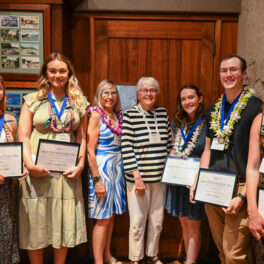Experiential program brings volcanoes to Hawai‘i high school, community college students
 Reed Mershon (right) and two student participants investigate volcanic rocks at Makapu'u, O'ahu.
Reed Mershon (right) and two student participants investigate volcanic rocks at Makapu'u, O'ahu.Oʻahu high school and community college students explored Hawaiʻi’s volcanoes and their hazards through a combination of field experiences and hands-on classroom activities. The week-long experience was offered by University of Hawaiʻi at Mānoa and Hawaiʻi Pacific University Earth scientists in summer 2023.
“The goal of the program was to connect the local students with Hawaiian geology and hopefully inspire them to pursue a path in the geosciences,” said Aaron Pietruszka, program co-instructor and associate professor in the Department of Earth Sciences at UH Mānoa’s School of Ocean and Earth Science and Technology (SOEST).
“We hoped to spark an interest in local geology by sharing information about the origins of the Hawaiian Islands and the volcanic and sedimentary processes that created the topography we see on O‘ahu,” said Reed Mershon, an Earth Sciences graduate student who was an assistant instructor.
The students, 15 from O‘ahu high schools and one from Kapi‘olani Community College, participated in field trips and interactive classroom activities that brought to life the science and hazards of volcanoes.
One student, upon walking around the Lānaʻi Lookout on O‘ahu, said, “I’ve passed by this place a million times and never thought about how it got there. It’s so cool to finally learn how and why O‘ahu looks the way it does.”
Lānaʻi Lookout is a volcaniclastic (rock that contains volcanic material) deposit consisting of several ash layers deposited by nearby vents—the students were able to observe the variations in the ash layers, indicating the dynamic eruptive conditions.
The instructors also shared potential educational pathways and careers in the geosciences that are relevant to local students. In an effort to include and welcome students who are from groups that are underrepresented in STEM fields, this program looked at volcanology with an Indigenous Hawaiian viewpoint.
“We connected the storytelling and history of the Hawaiian Islands with the local geology,” said Mershon.
Simulated volcanic hazards
To introduce volcanic hazards preparedness, Andrew Greene, program co-instructor and associate professor at HPU, developed the “2018 Kīlauea Eruption Simulation: A Volcanic Crisis Role‐Play Simulation and Training Activity.”
“It’s quite tricky, as there are so many moving parts: how will the electric company respond? What will Civil Defense do? How about the city manager?,” said Mershon. “The situation is constantly changing and every moment is crucial in preventing a large-scale simulated disaster. It could have turned into chaos. But, wow! These students handled the stresses extremely well and took all the necessary steps to maintain order and safety. I was extremely impressed.”
Current activity, ancient processes
Through the NSF-funded project, the research team recently assembled what is likely the most complete collection of samples from the Emperor Seamounts. This includes samples from drill cores, dredges, and lava collected by remotely-operated vehicles. Some of the lava samples from the Hawaiian-Emperor Chain are extremely old—as old as 80 million years.
Mershon brought in a few samples for the students to observe and touch. After seeing a 45 million year old lava from Koko Seamount, one student said, “But wait, this looks just like the rocks near my house!”
“The rocks near their house and the rocks from these seamounts are extremely similar,” said Mershon. “It was really satisfying to see the student make this connection and realize that the current volcanic processes we see on Hawai‘i Island are the same processes that created the ancient lava.”
The program was offered for the first time this past summer and included a $500 stipend for each participant as well as lunches and transportation for field trips. The team plans to offer it again in the summer of 2024. To be notified when the application period for the program opens, email your request to apietrus@hawaii.edu.
Read also on UH News.


